Prediction of Hot Formability of AA7075 Aluminum Alloy Sheet
Abstract
:1. Introduction
2. Uniaxial High-Temperature Tensile Test
2.1. Test Scheme
2.2. Force–Displacement Curves
3. Constitutive Model
4. Fracture Model
5. Forming Limit Prediction
5.1. Theoretical Forming Limit Curve
5.2. Prediction Accuracy Assessment
6. Conclusions
- (1)
- The Johnson–Cook constitutive model was constructed and modified based on the high-temperature uniaxial tensile test of AA7075 aluminum alloy. The modified Johnson–Cook constitutive model has good applicability by modifying the Holloman hardening model to the Swift–Voce hardening model.
- (2)
- After the Johnson–Cook fracture model of AA7075 aluminum alloy was constructed, error evaluation was conducted based on 44 combination schemes calibrated by the model. The optimal combination scheme of specimens and optimal values of five failure parameters were determined. Based on the Johnson–Cook fracture model, the theoretical forming limit curves were obtained for different strain rates and temperatures.
- (3)
- The reliability of the Johnson–Cook fracture model was predicted and evaluated through a Nakazima test of an AA7075 aluminum alloy circular plate. The experimental fracture location was in good agreement with the simulated fracture location, and the fracture displacement error was controlled within 5%. The results show that the prediction accuracy of circular-plate bulging based on the Johnson–Cook fracture model simulation prediction is high, which confirms the high accuracy of the obtained theoretical forming limit curve.
Author Contributions
Funding
Institutional Review Board Statement
Informed Consent Statement
Data Availability Statement
Conflicts of Interest
References
- Andilab, B.; Vandersluis, E.; Emadi, P.; Ravindran, C.; Byczynski, G.; Fernandez-Gutierrez, R. Characterization of a cast Al-Cu alloy for automotive cylinder head applications. J. Mater. Eng. Perform. 2022, 31, 5679–5688. [Google Scholar] [CrossRef]
- Wojdat, T.; Kustron, P.; Jaskiewicz, K.; Zwierzchowski, M.; Margielewska, A. Numerical modelling of welding of car body sheets made of selected aluminium alloys. Arch. Metall. Mater. 2019, 64, 1403–1409. [Google Scholar]
- Wu, B.T.; Pan, Z.X.; Ziping, Y.; van Duin, S.; Li, H.J.; Pierson, E. Robotic skeleton arc additive manufacturing of aluminium alloy. Int. J. Adv. Manuf. Technol. 2021, 114, 2945–2959. [Google Scholar] [CrossRef]
- Kablov, E.N.; Antipov, V.V.; Oglodkova, J.S.; Oglodkov, M.S. Development and application prospects of aluminum-lithium alloys in aircraft and space technology. Metallurgist 2021, 65, 72–81. [Google Scholar] [CrossRef]
- Wang, X.J.; Sun, W.; Chen, J.F.; Wang, F.Y.; Li, L.; Cui, J.Z. Microstructures and properties of 6016 aluminum alloy with gradient composition. Rare Met. 2021, 40, 2154–2159. [Google Scholar] [CrossRef]
- Kenevisi, M.S.; Yu, Y.F.; Lin, F. A review on additive manufacturing of Al-Cu (2xxx) aluminium alloys, processes and defects. Mater. Sci. Technol. 2021, 37, 805–829. [Google Scholar] [CrossRef]
- Liu, W.; Zou, X.F.; Lei, Y. Improving shape accuracy of aluminium alloy surface part in electromagnetically-assisted stamping. Int. J. Mater. Prod. Technol. 2020, 60, 260–273. [Google Scholar] [CrossRef]
- Ponnusamy, P.; Rashid, R.A.R.; Masood, S.H.; Ruan, D.; Palanisamy, S. Mechanical properties of SLM-Printed aluminium alloys: A review. Materials 2020, 13, 4301. [Google Scholar] [CrossRef]
- Simonetto, E.; Bertolini, R.; Ghiotti, A.; Bruschi, S. Mechanical and microstructural behaviour of 7075-T6 aluminium alloy for sub-zero temperature sheet stamping process. Int. J. Mech. Sci. 2020, 187, 105919. [Google Scholar] [CrossRef]
- Gao, H.X.; El Fakir, O.; Wang, L.L.; Politis, D.J.; Li, Z.Q. Forming limit prediction for hot stamping processes featuring non-isothermal and complex loading conditions. Int. J. Mech. Sci. 2017, 131, 792–810. [Google Scholar] [CrossRef]
- Mallick, P.K.; Sheng, Z.Q. Predicting sheet forming limit of aluminum alloys for cold and warm forming by developing a ductile failure criterion. J. Manuf. Sci. E-T. ASME 2017, 139, 111018. [Google Scholar]
- Zhan, X.P.; Wang, Z.H.; Li, M.; Hu, Q.; Chen, J. Investigations on failure-to-fracture mechanism and prediction of forming limit for aluminum alloy incremental forming process. J. Mater. Process. Technol. 2020, 282, 116687. [Google Scholar] [CrossRef]
- Chakrabarty, S.; Bhargava, M.; Narula, H.K.; Pant, P.; Mishra, S.K. Prediction of strain path and forming limit curve of AHSS by incorporating microstructure evolution. Int. J. Adv. Manuf. Technol. 2020, 106, 5085–5098. [Google Scholar] [CrossRef]
- Yang, Z.Y.; Zhao, C.C.; Dong, G.J.; Chen, Z.W. Experimental Calibration of ductile fracture parameters and forming limit of AA7075-T6 sheet. J. Mater. Process. Technol. 2021, 291, 117044. [Google Scholar] [CrossRef]
- Morchhale, A.; Badrish, A.; Kotkunde, N.; Singh, S.K.; Khanna, N.; Saxena, A.; Nikhare, C. Prediction of fracture limits of Ni-Cr based alloy under warm forming condition using ductile damage models and numerical method. Trans. Nonferrous Met. Soc. China 2021, 31, 2372–2387. [Google Scholar] [CrossRef]
- Goksen, S.; Darendeliler, H. The Effect of Strain Rate and Temperature on Forming Limit Diagram for DKP-6112 and AZ31 Materials. In Proceedings of the 23rd International Conference on Material Forming, online, 4–8 May 2020. [Google Scholar]
- Nasri, M.T.; Abbassi, F.; Ahmad, F.; Makhloufi, W.; Ayadi, M.; Mehboob, H.; Choi, H.S. Experimental and numerical investigation of sheet metal failure based on Johnson-Cook model and Erichsen test over a wide range of temperatures. Mech. Adv. Mater. Struct. 2022. [Google Scholar] [CrossRef]
- Hidalgo-Manrique, P.; Cao, S.; Shercliff, H.R.; Hunt, R.D.; Robson, J.D. Microstructure and properties of aluminium alloy 6082 formed by the hot form quench process. Mater. Sci. Eng. A 2021, 804, 140751. [Google Scholar] [CrossRef]
- Barenji, A.B.; Eivani, A.R.; Hasheminiasari, M.; Jafarian, H.R.; Park, N. Effects of hot forming cold die quenching and inter-pass solution treatment on the evolution of microstructure and mechanical properties of AA2024 aluminum alloy after equal channel angular pressing. J. Mater. Res. Technol. 2020, 9, 1683–1697. [Google Scholar] [CrossRef]
- Garrett, R.P.; Lin, J.; Dean, T.A. An Investigation of the effects of solution heat treatment on mechanical properties for AA 6xxx alloys: Experimentation and modelling. Int. J. Plast. 2005, 21, 1640–1657. [Google Scholar] [CrossRef]
- Dunand, M.; Mohr, D. Hybrid experimental–numerical analysis of basic ductile fracture experiments for sheet metals. Int. J. Solids Struct. 2010, 47, 1130–1143. [Google Scholar] [CrossRef]
- Johnson, G.R.; Cook, W.H. Fracture characteristics of three metals subjected to various strains, strain rates, temperatures and pressure. Eng. Fract. Mech. 1985, 21, 31–48. [Google Scholar] [CrossRef]
- Jia, Z.; Guan, B.; Zang, Y.; Wang, Y.; Mu, L. Modified Johnson-Cook model of aluminum alloy 6016-T6 sheets at low dynamic strain rates. Mater. Sci. Eng. A 2021, 820, 141565. [Google Scholar] [CrossRef]
- Wang, C.J.; Wang, H.Y.; Chen, G.; Zhu, Q.; Zhang, P.; Fu, M.W. Experiment and modeling based studies of the mesoscaled deformation and forming limit of Cu/Ni clad foils using a newly developed damage model. Int. J. Plast. 2022, 149, 103173. [Google Scholar] [CrossRef]
- Yao, D.; Pu, S.L.; Li, M.Y.; Guan, Y.P.; Duan, Y.C. Parameter identification method of the semi-coupled fracture model for 6061 aluminium alloy sheet based on machine learning assistance. Int. J. Solids Struct. 2022, 254, 111823. [Google Scholar] [CrossRef]
- Ganjiani, M.; Homayounfard, M. Development of a ductile failure model sensitive to stress triaxiality and Lode angle. Int. J. Solids Struct. 2021, 225, 111066. [Google Scholar] [CrossRef]
- Abbassi, F.; Belhadj, T.; Mistou, S.; Zghal, A. Parameter identification of a mechanical ductile damage using Artificial Neural Networks in sheet metal forming. Mater. Des. 2013, 45, 605–615. [Google Scholar] [CrossRef] [Green Version]
- Abbassi, F.; Mistou, S.; Zghal, A. Failure analysis based on microvoid growth for sheet metal during uniaxial and biaxial tensile tests. Mater. Des. 2013, 49, 638–646. [Google Scholar] [CrossRef] [Green Version]
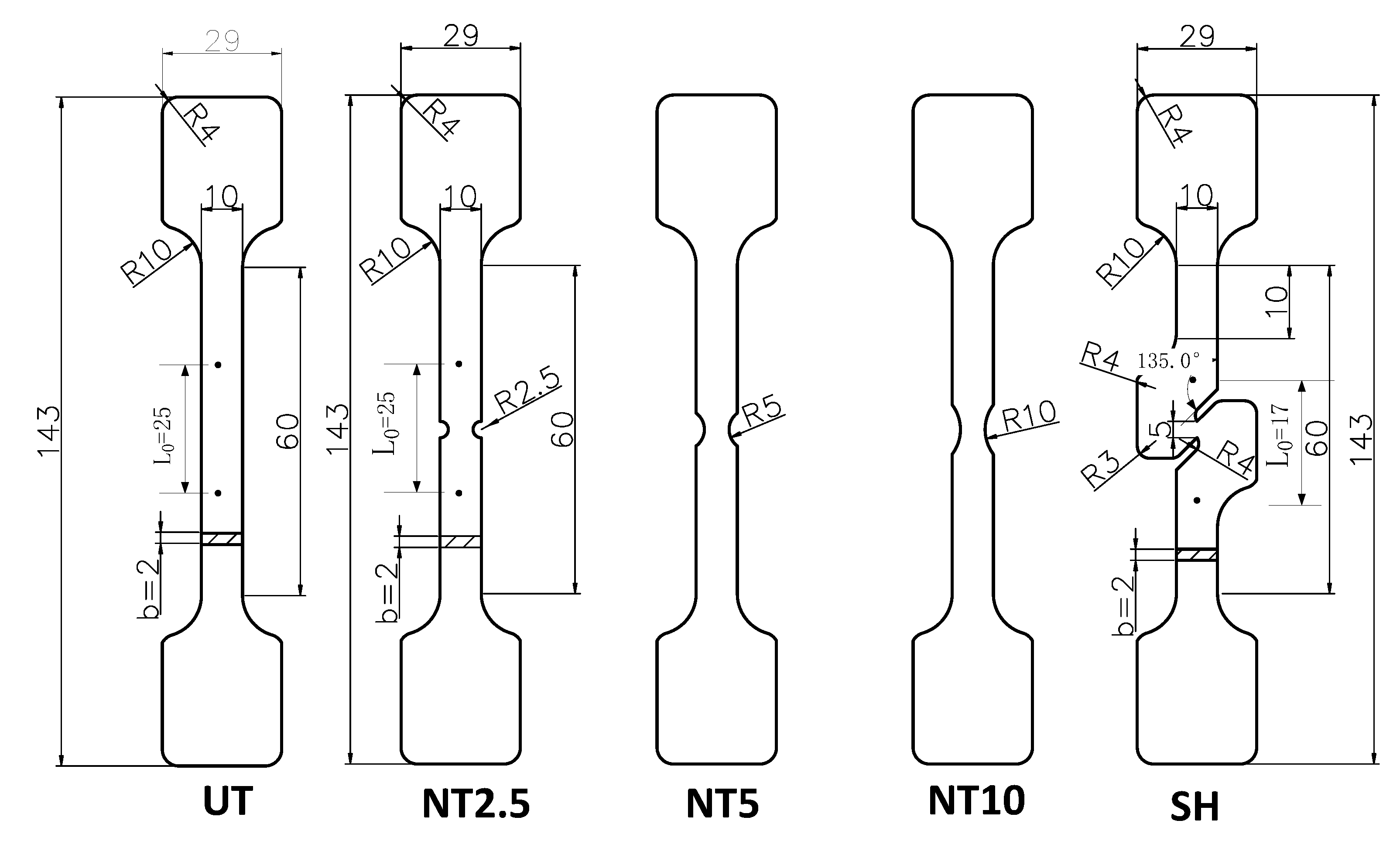
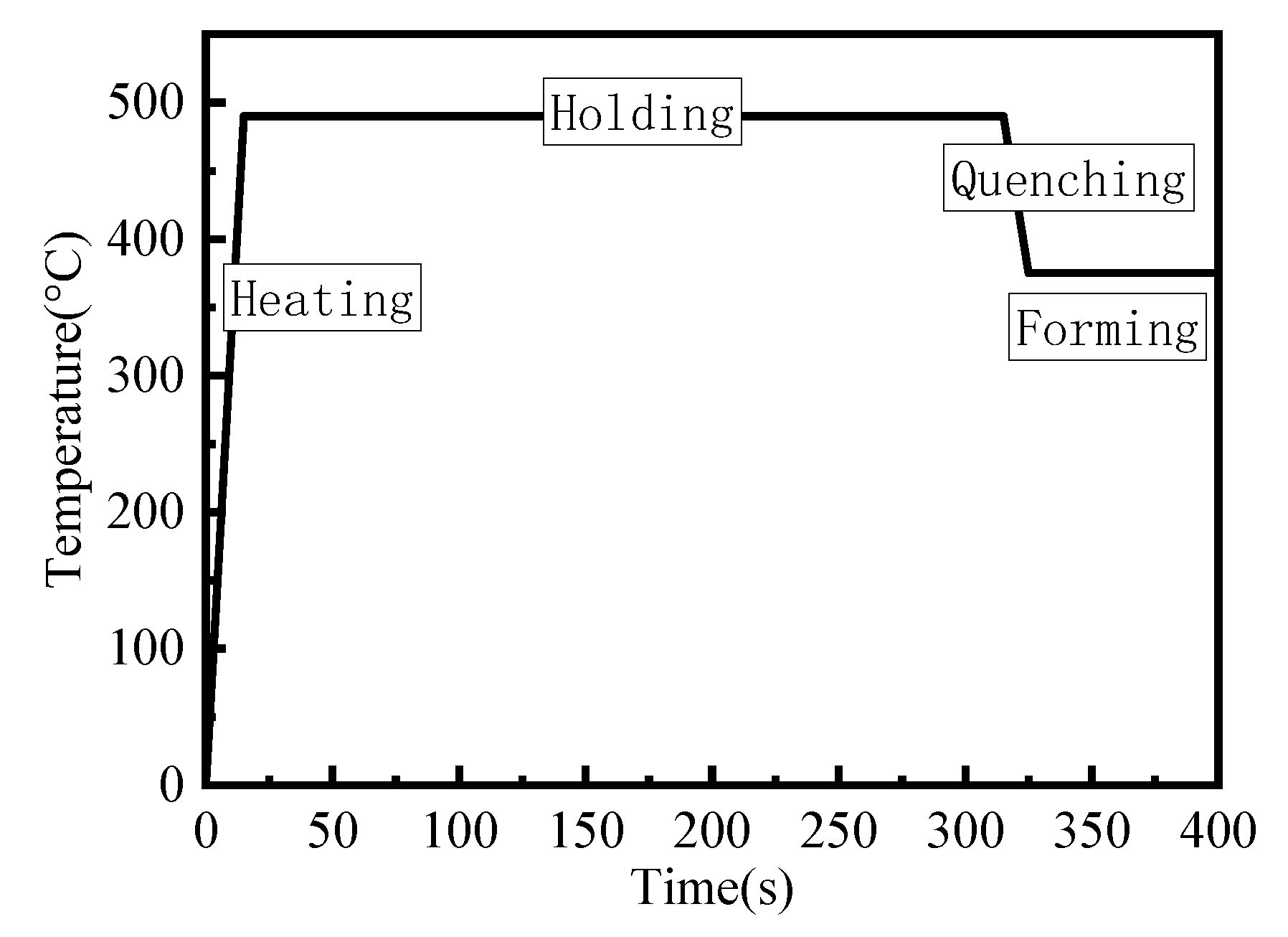
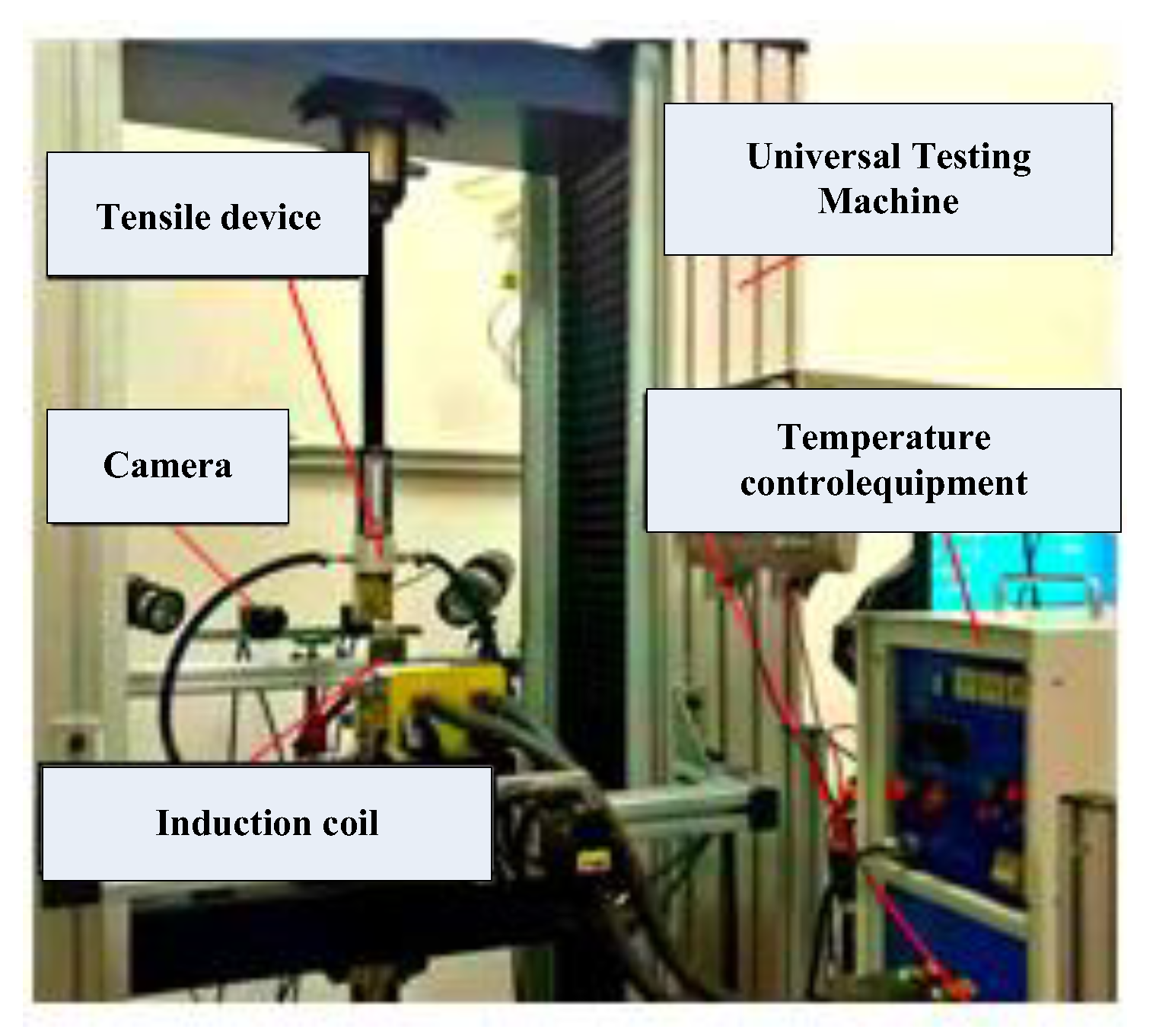

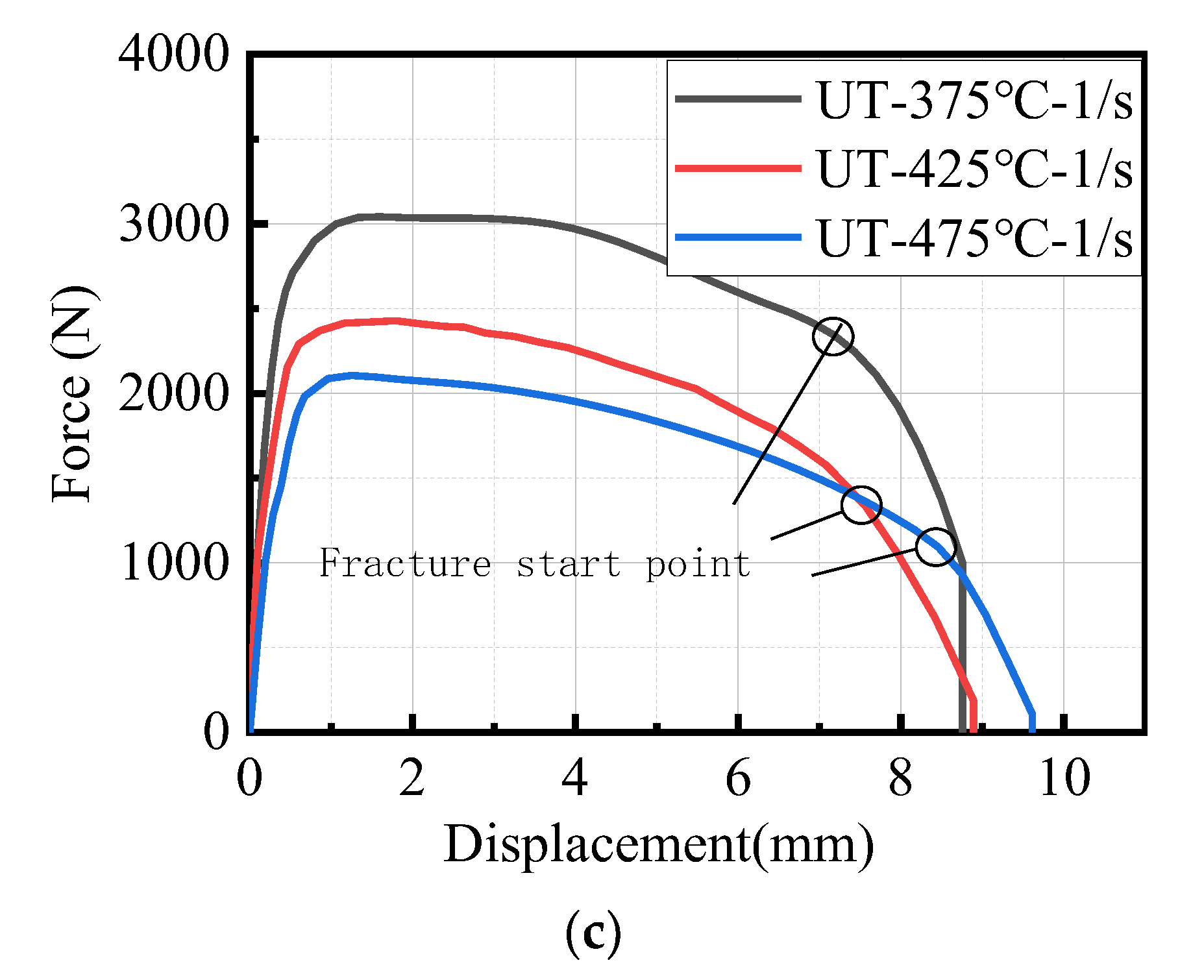
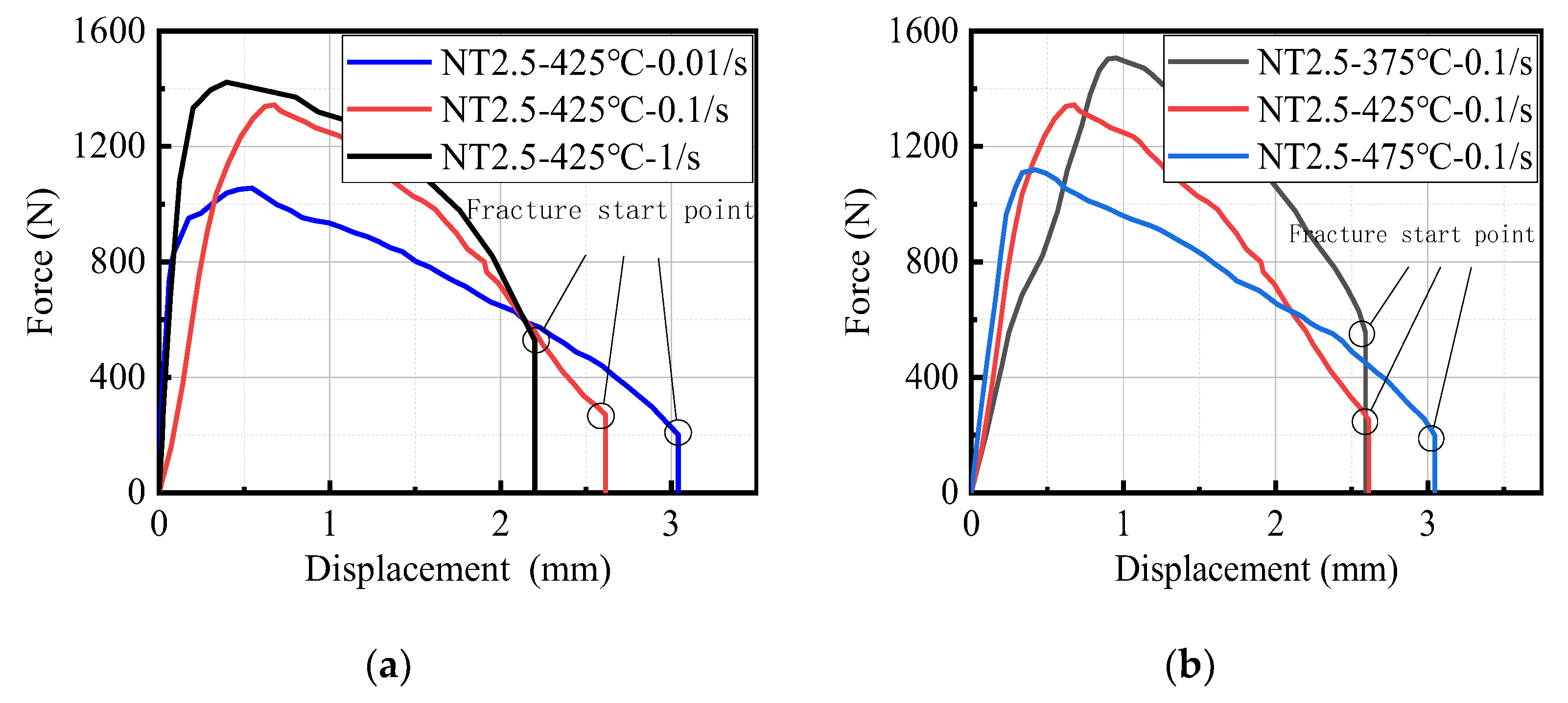
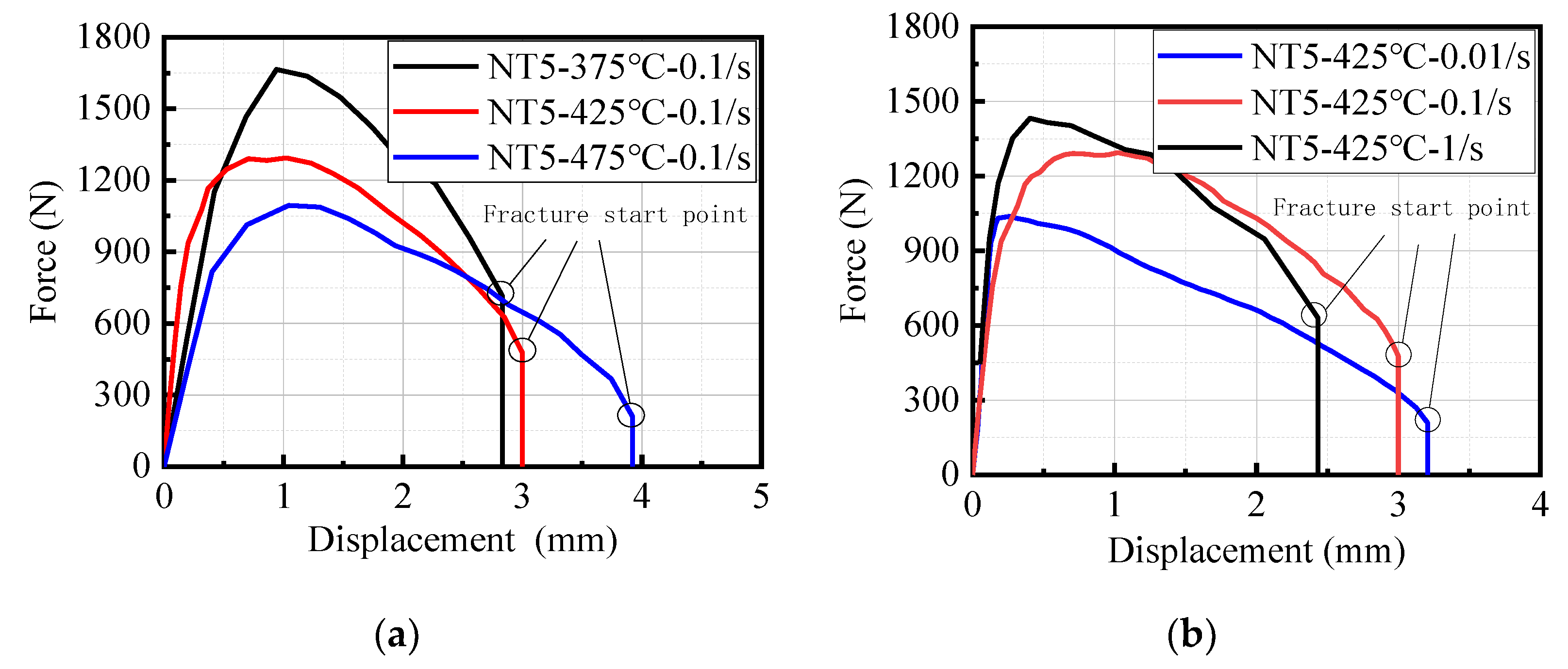
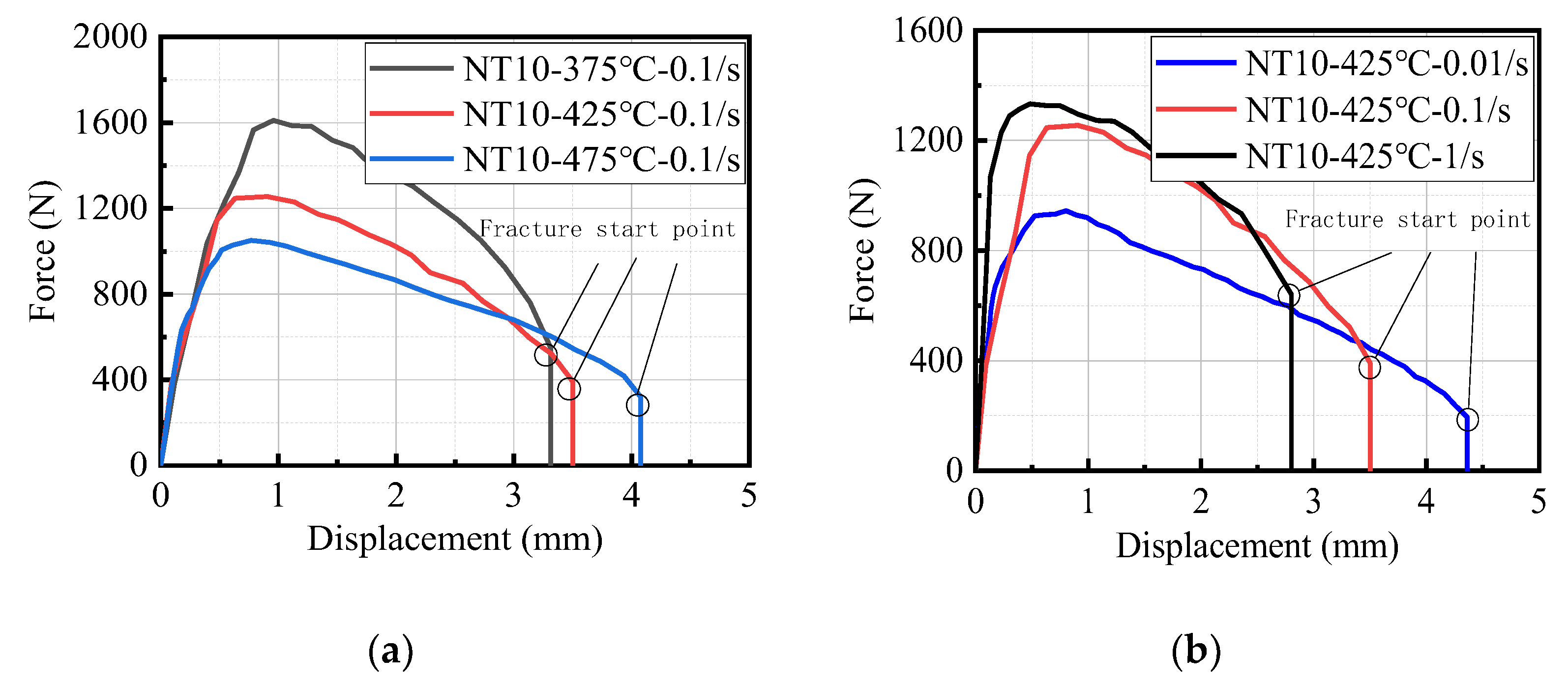
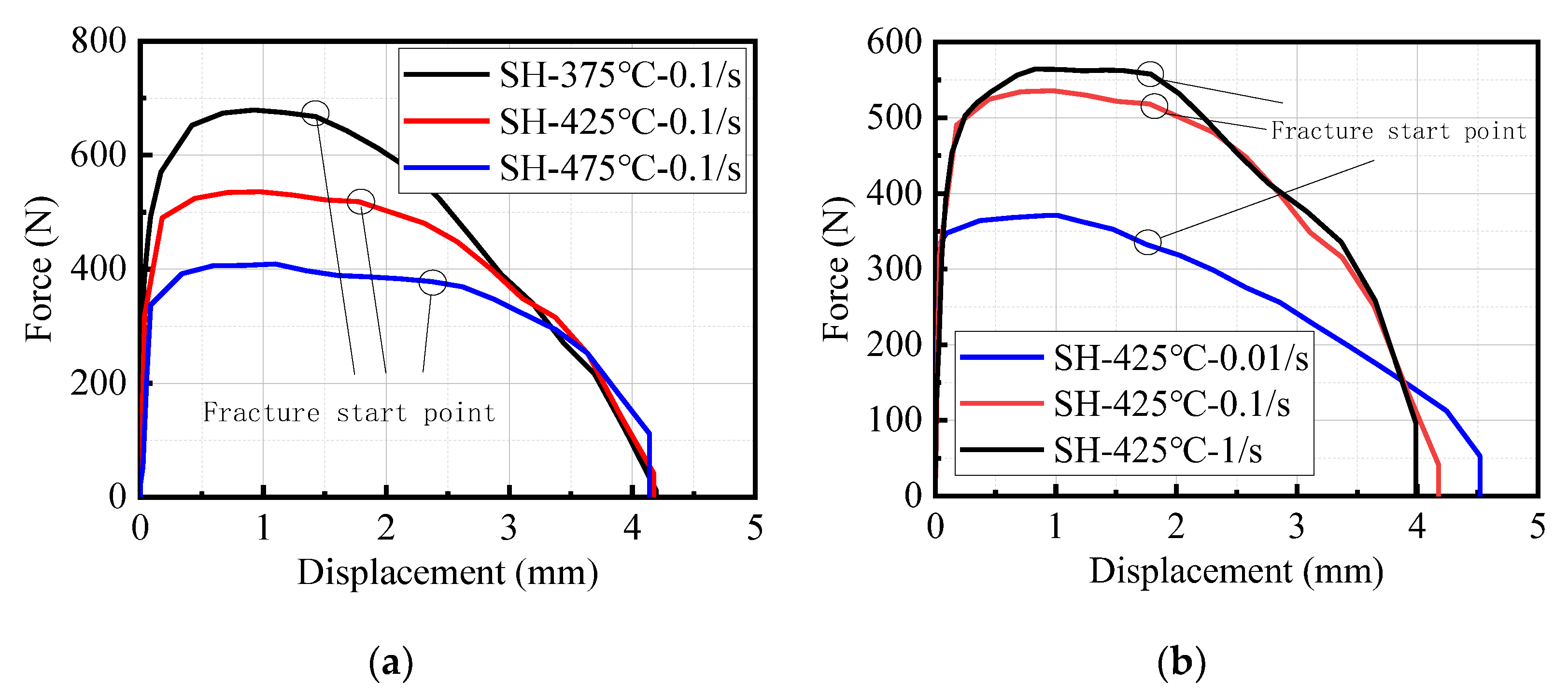


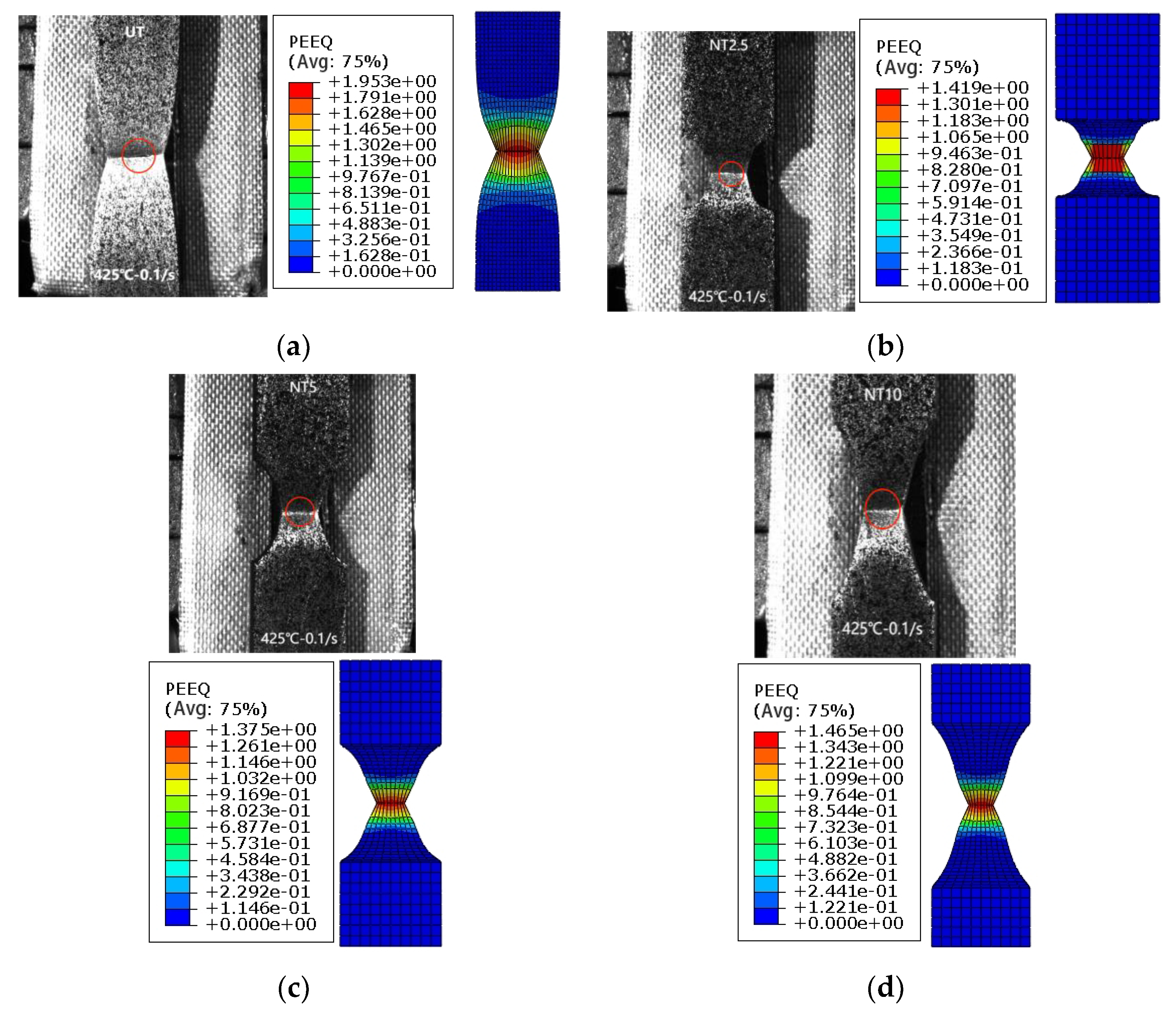

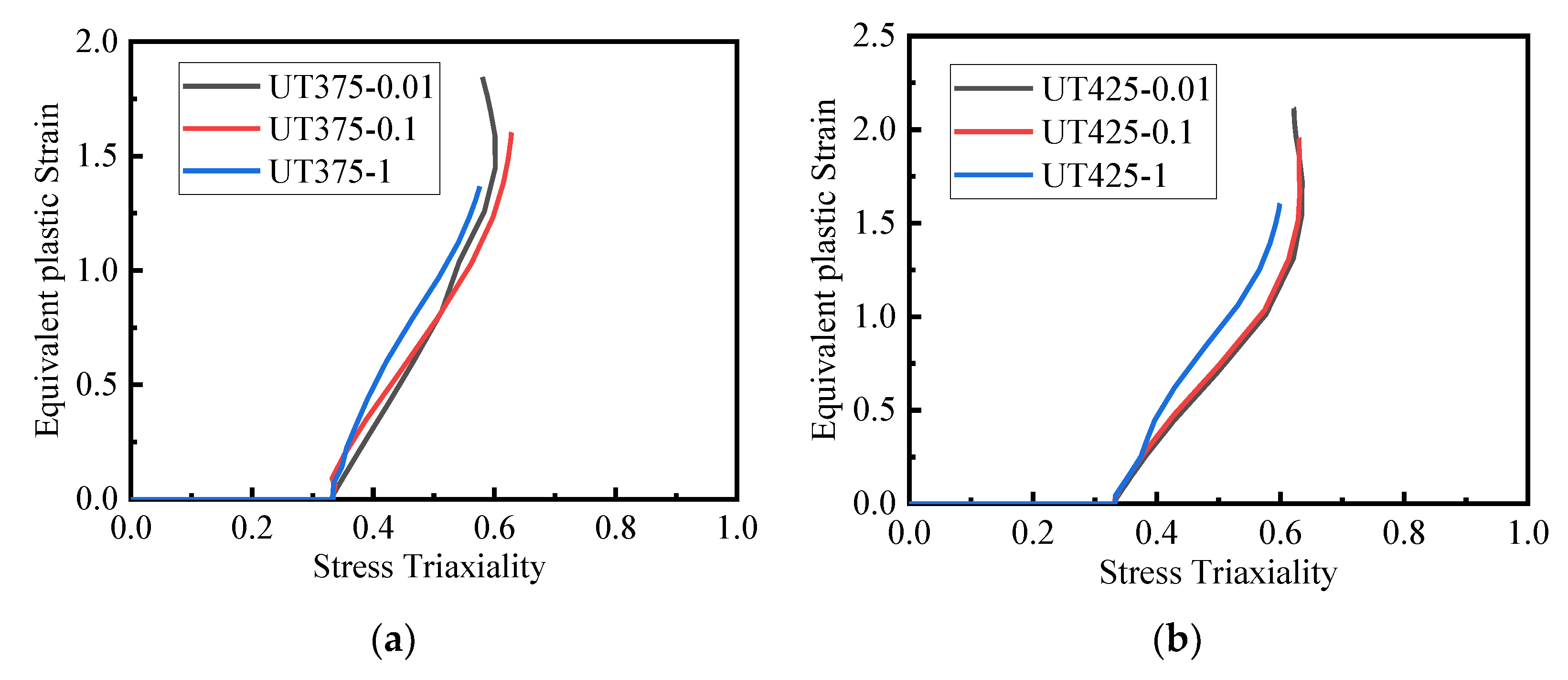
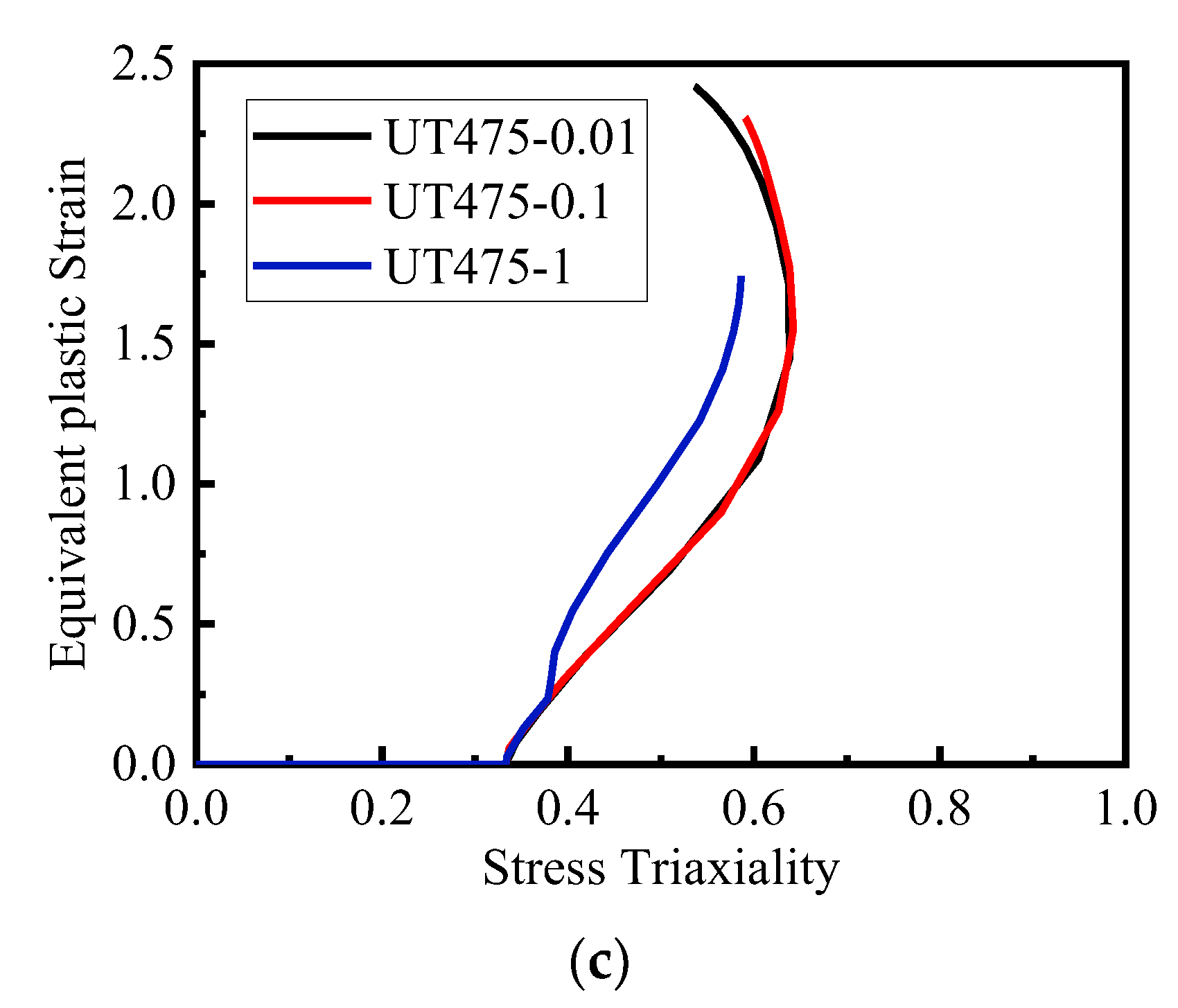
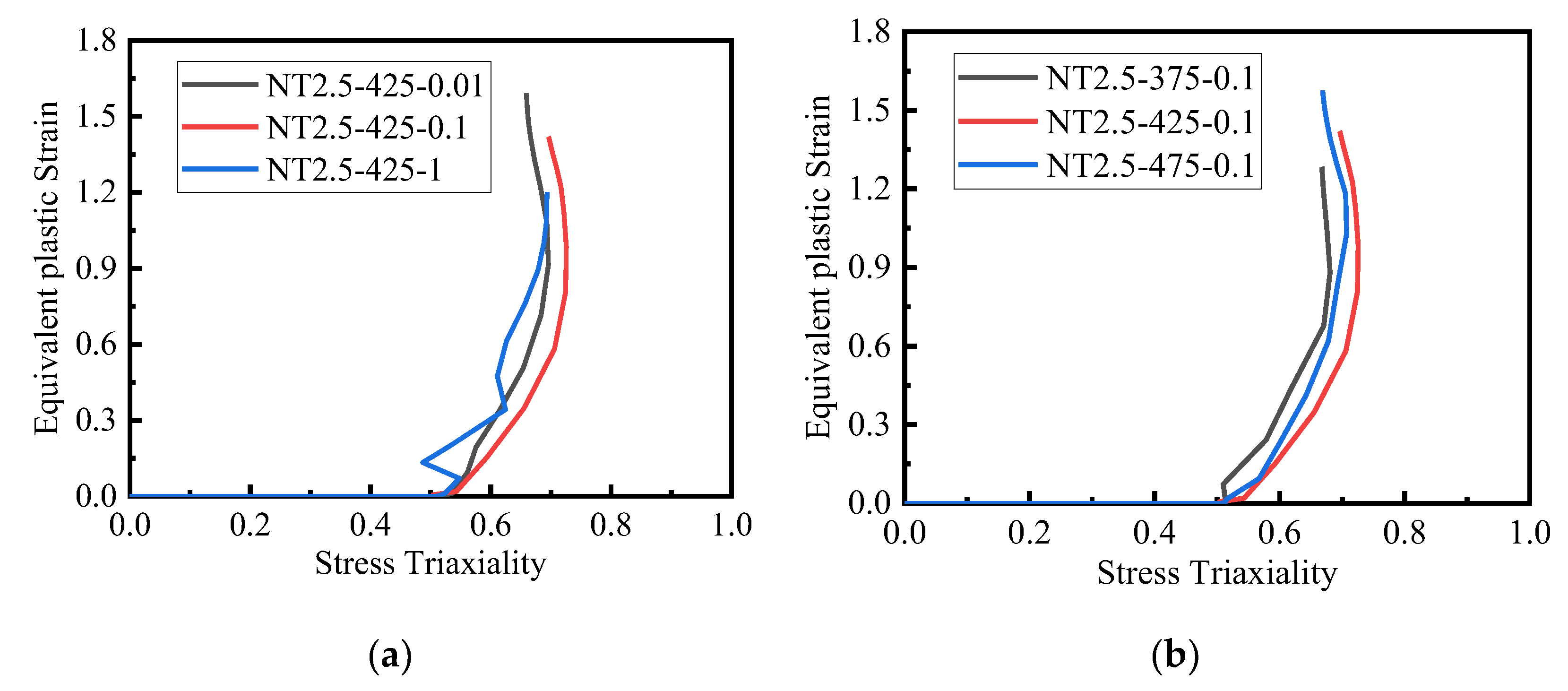
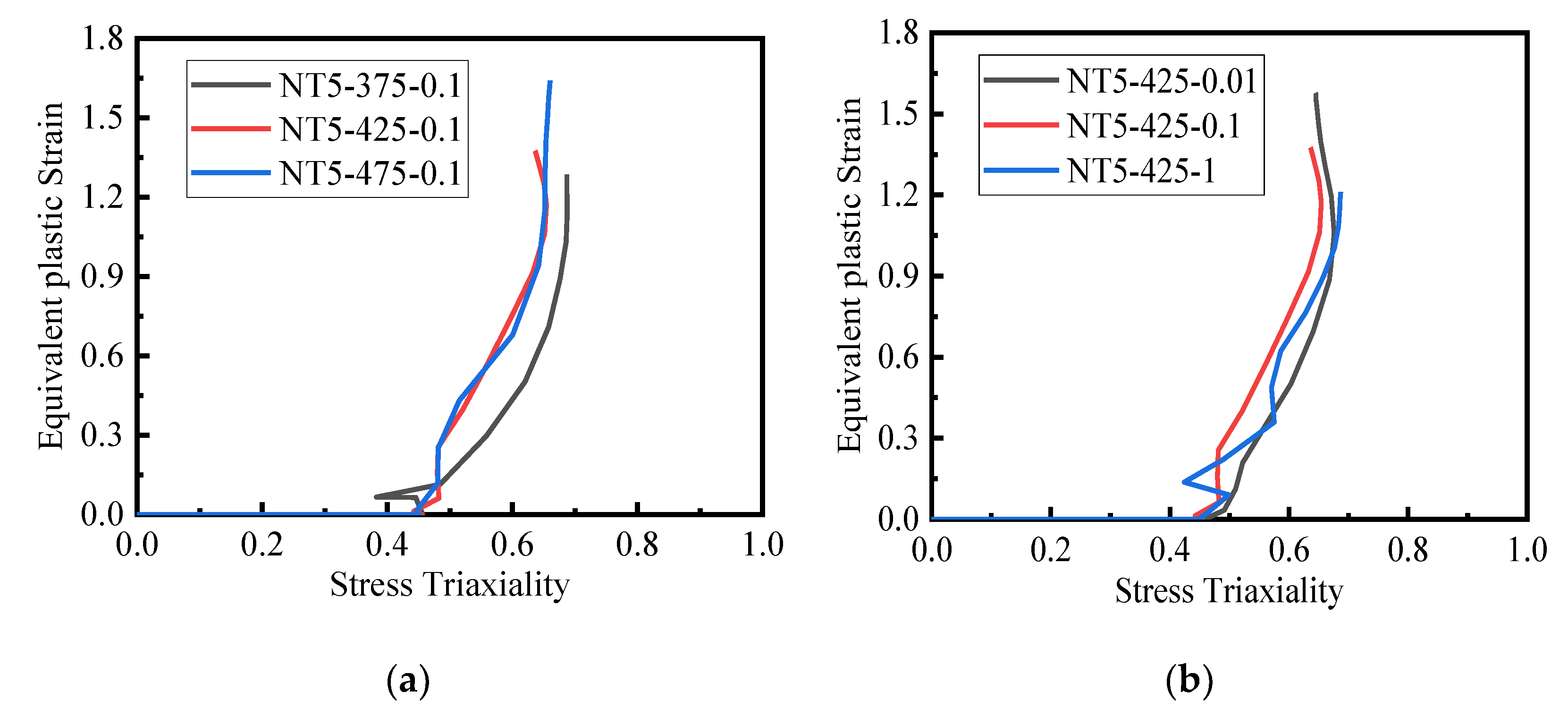
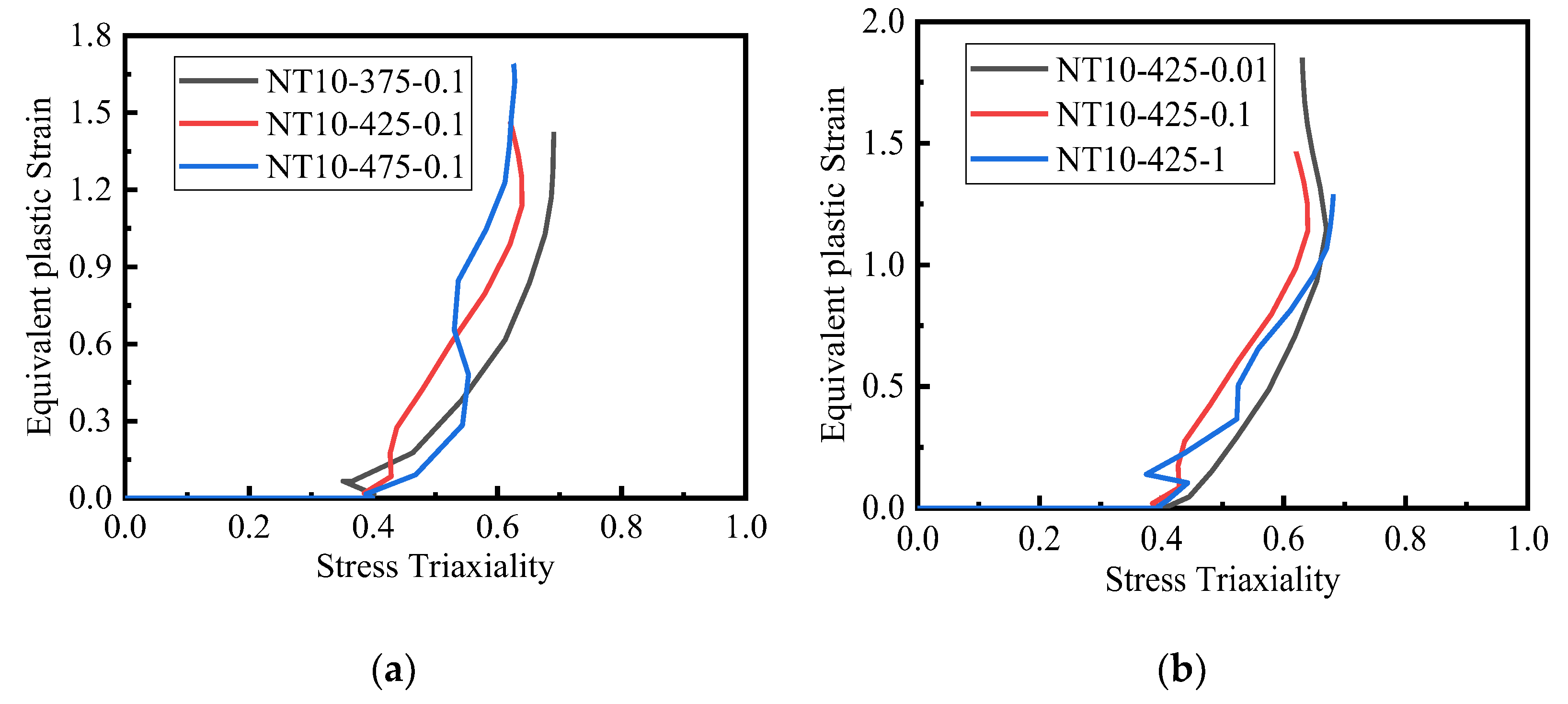
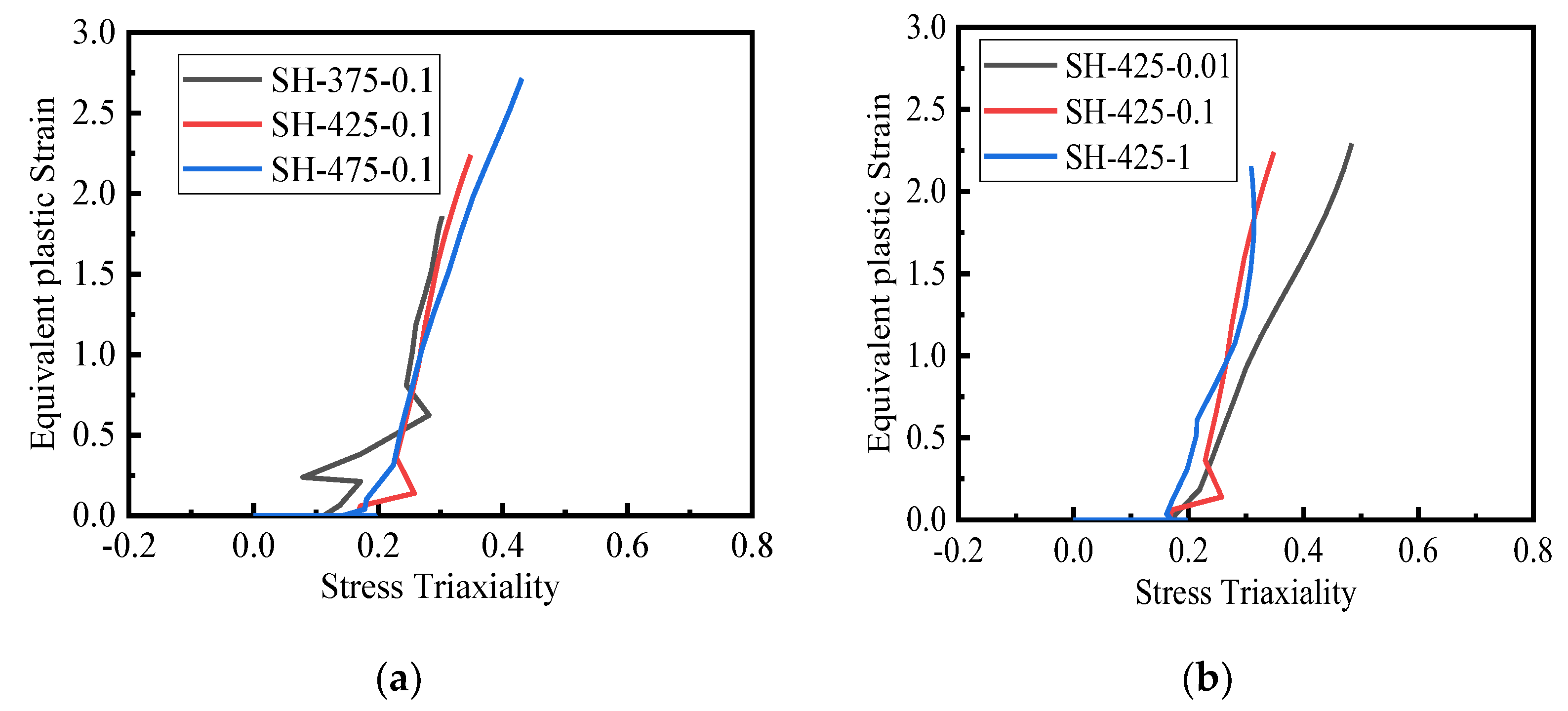
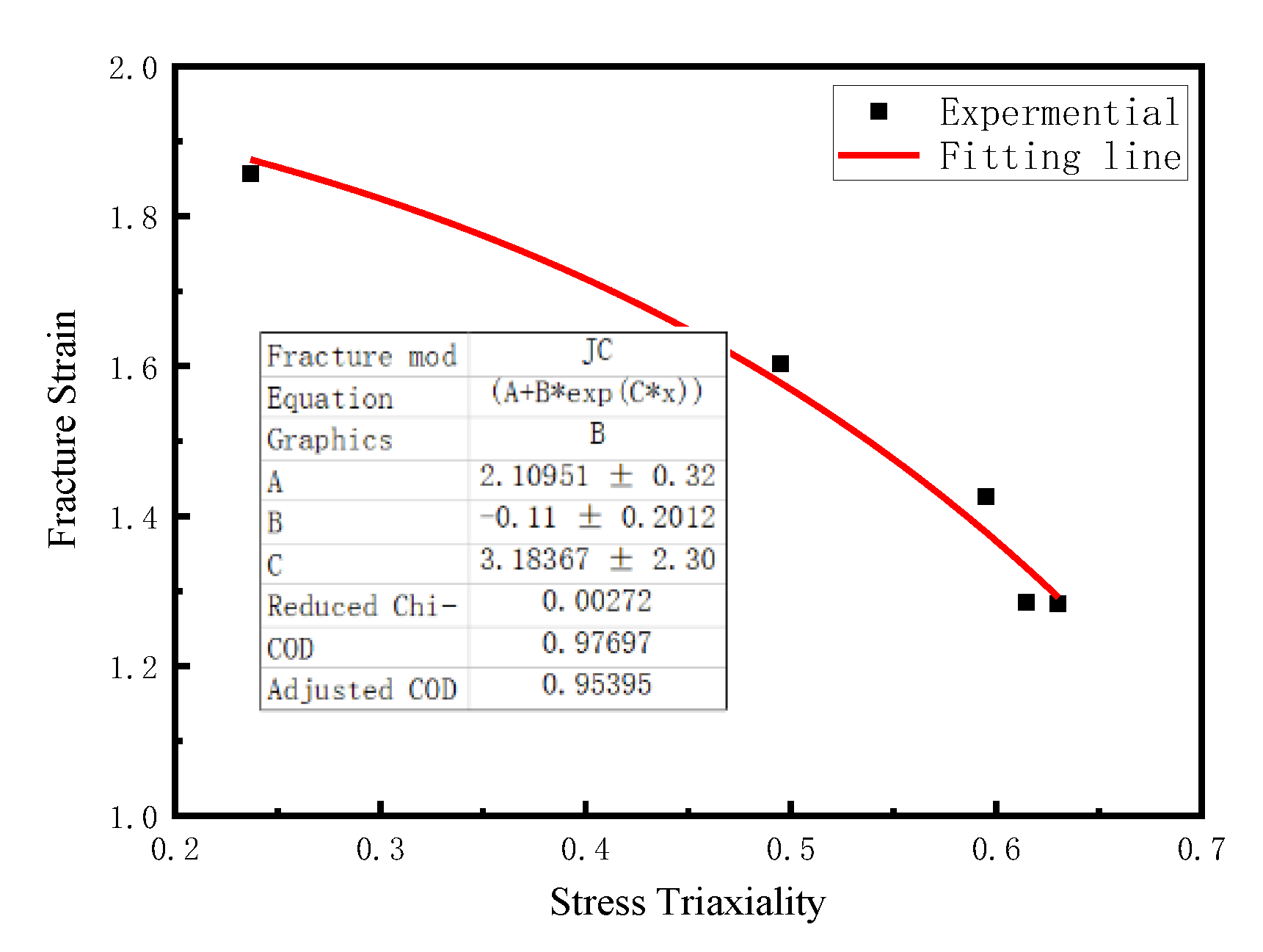

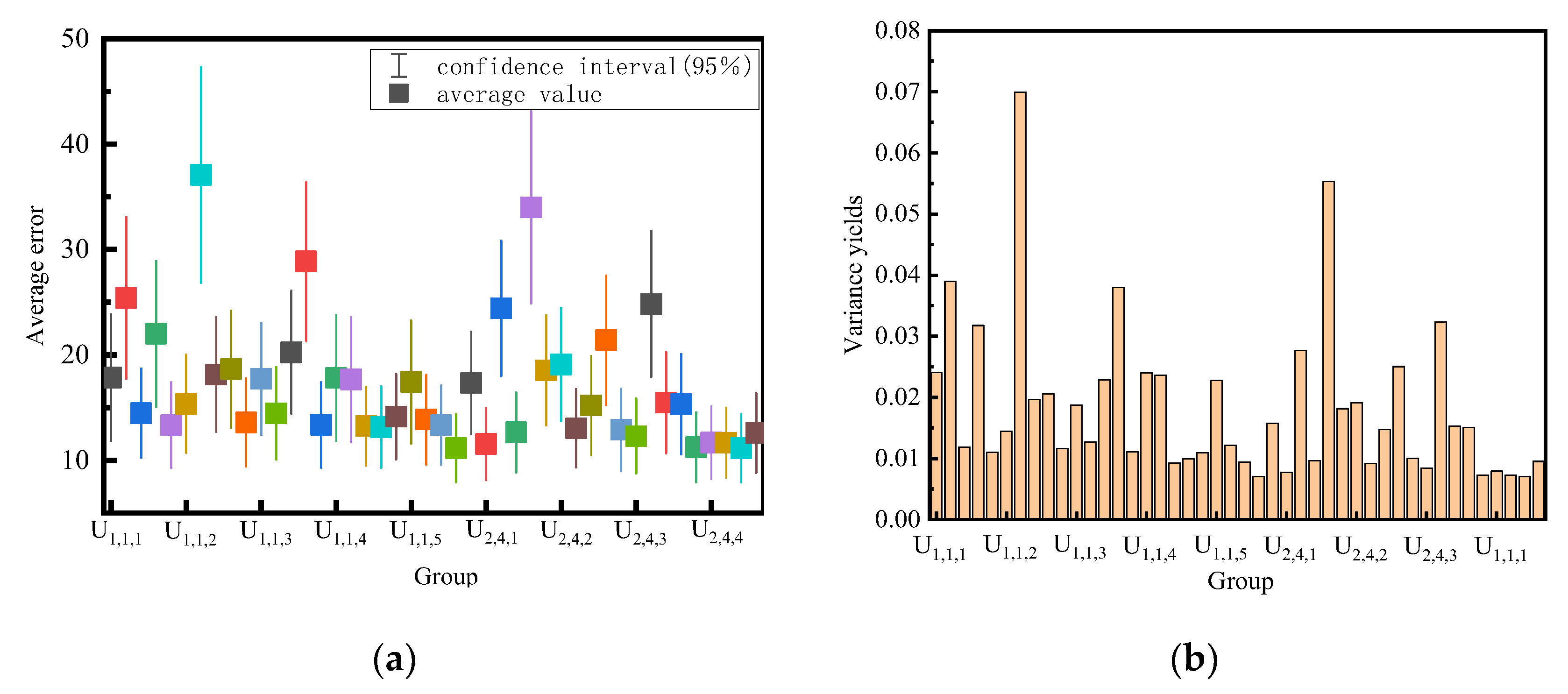
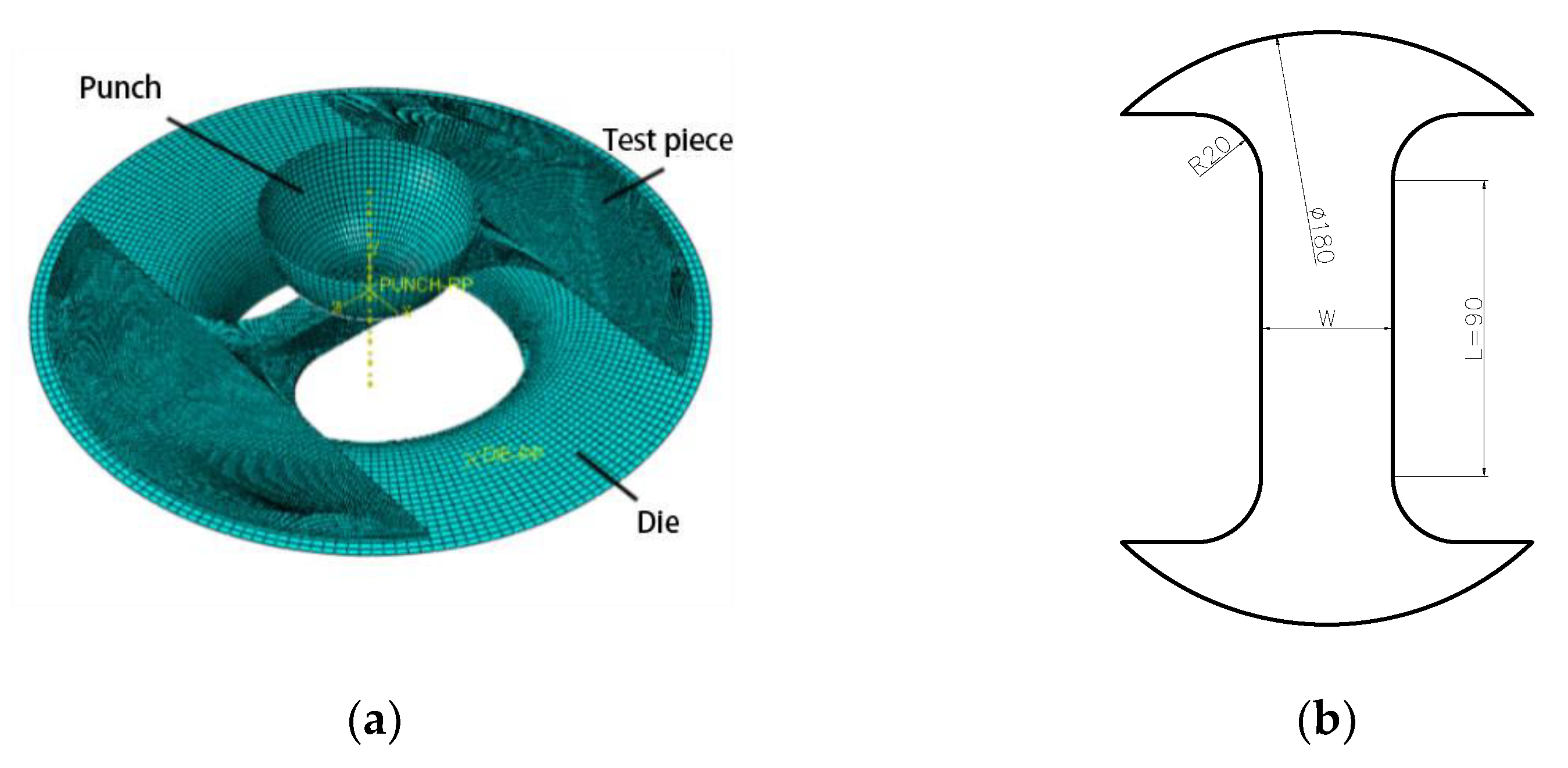
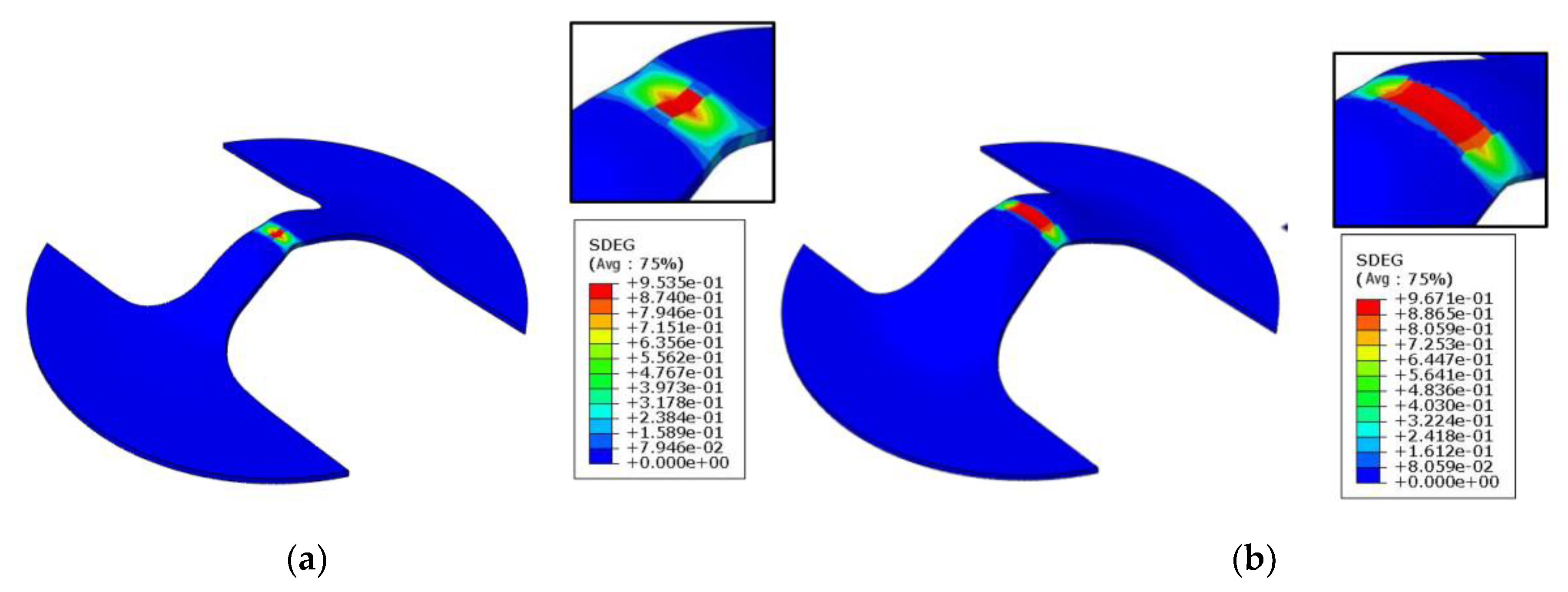
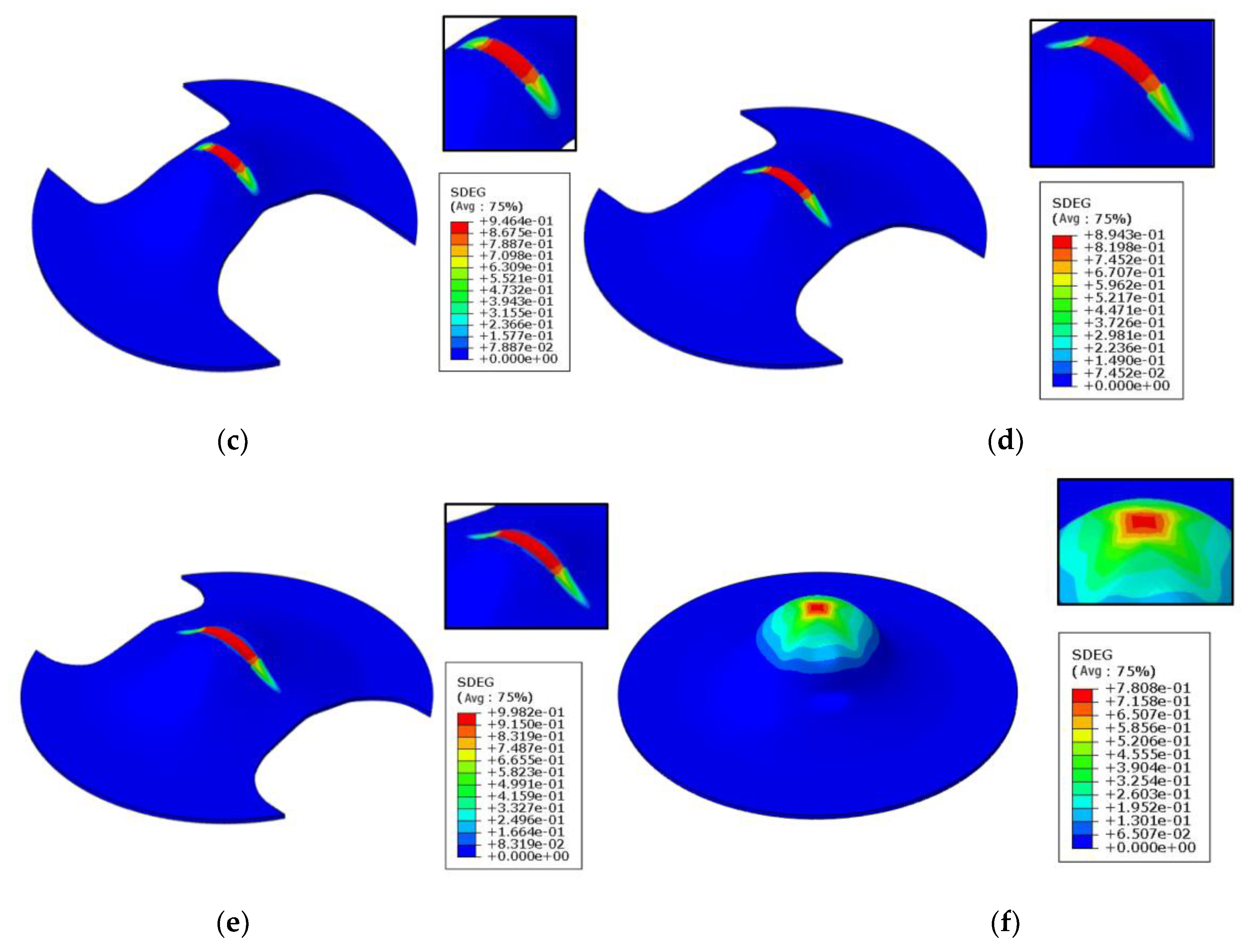

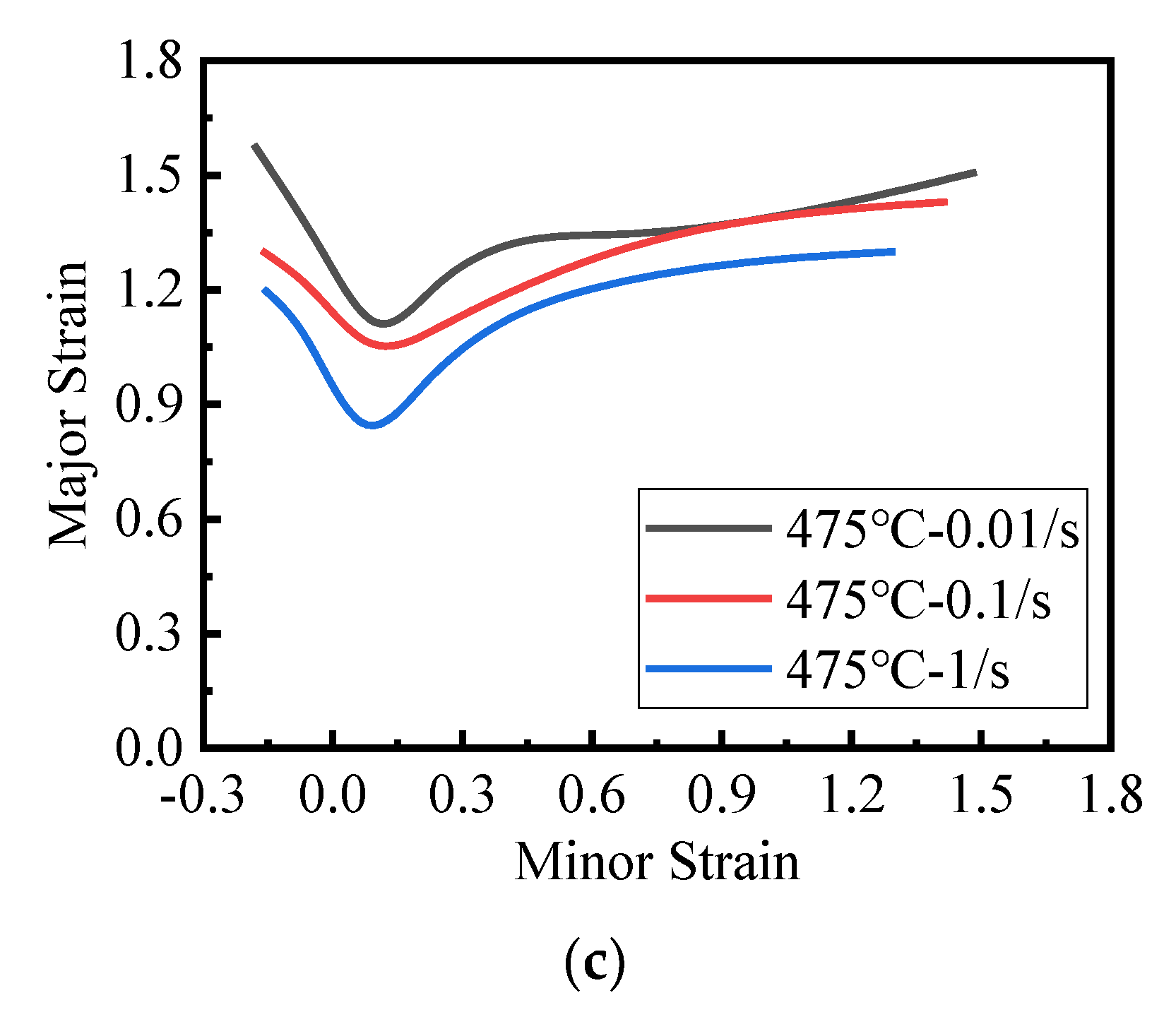
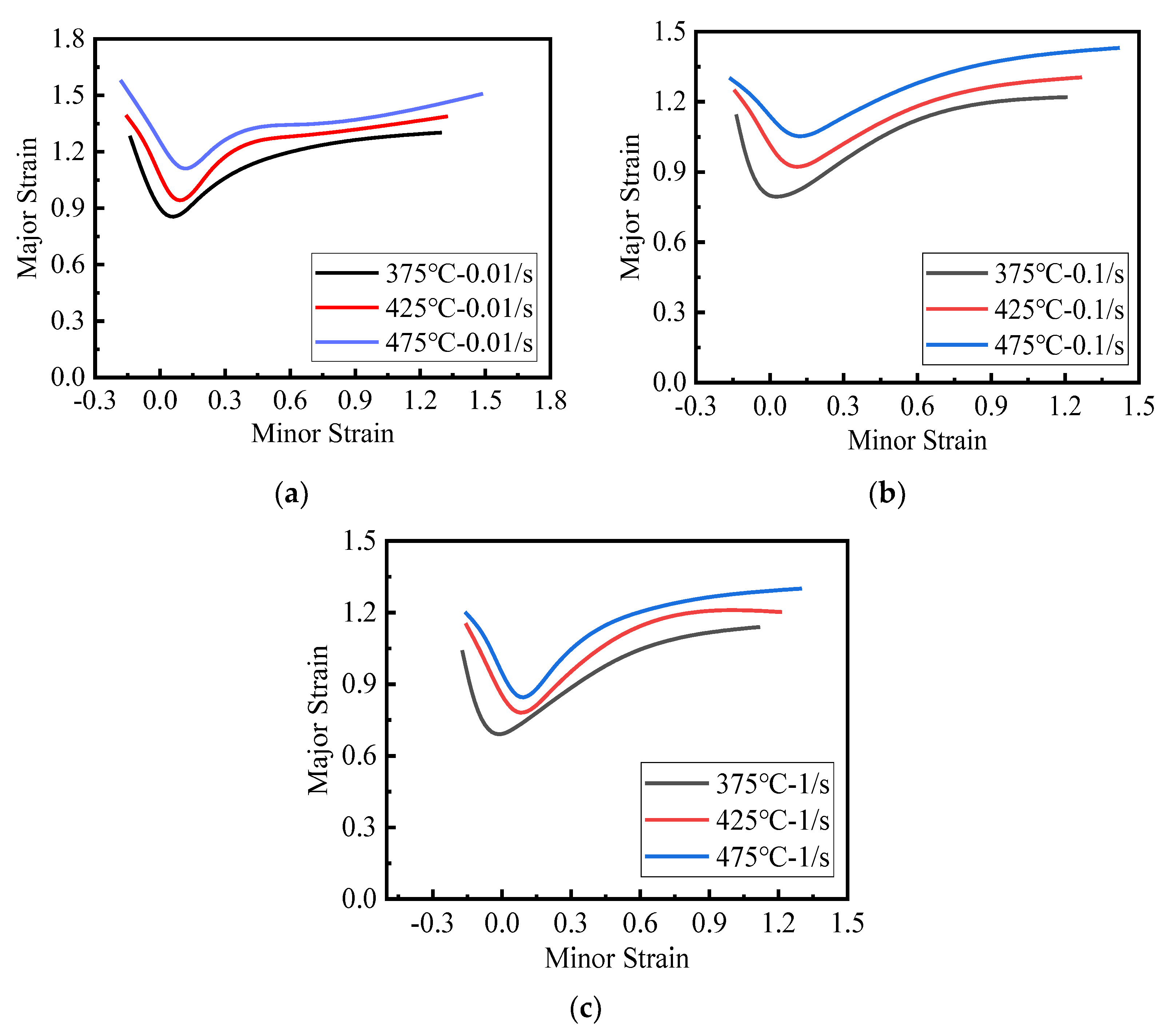
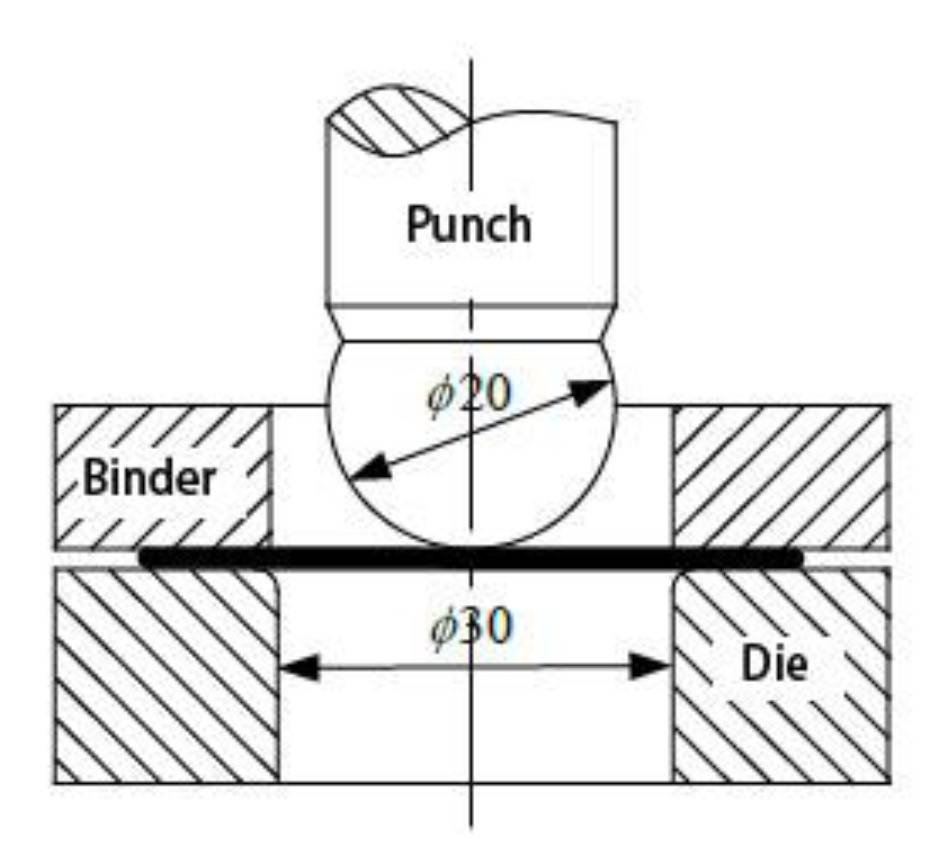



| Si | Fe | Cu | Mn | Mg | Cr | Zn | Ti | Al |
|---|---|---|---|---|---|---|---|---|
| 0.17 | 0.22 | 1.57 | 0.11 | 2.46 | 0.20 | 5.63 | 0.09 | - |
| Temperature (°C) | Strain Rate (/s) | K | B | C |
|---|---|---|---|---|
| 375 | 0.01 | 92.07117 | 473.01661 | 3.00000 |
| 0.1 | −414.94421 | 115.57266 | −0.12683 | |
| 1 | 328.87782 | 81.24024 | −0.17783 | |
| 425 | 0.01 | 259.48459 | 412.40667 | 0.50000 |
| 0.1 | −3.73651 | 107.83479 | −0.16058 | |
| 1 | −1058.39724 | 144.79391 | 0.16687 | |
| 475 | 0.01 | 530.40297 | 338.87563 | −0.14784 |
| 0.1 | 309.89884 | 89.32858 | −0.04666 | |
| 1 | −691.78899 | 118.37685 | 0.28173 |
| Specimen Type | UT | NT2.5 | NT5 | NT10 | SH |
|---|---|---|---|---|---|
| 425-0.01 | Ui,1,1 | Ui,2,1 | Ui,3,1 | Ui,4,1 | Ui,5,1 |
| 425-0.1 | Ui,1,2 | Ui,2,2 | Ui,3,2 | Ui,4,2 | Ui,5,2 |
| 425-1 | Ui,1,3 | Ui,2,3 | Ui,3,3 | Ui,4,3 | Ui,5,3 |
| 475-0.1 | Ui,1,4 | Ui,2,4 | Ui,3,4 | Ui,4,4 | Ui,5,4 |
| 475-0.01 | Ui,1,5 | - | - | - | - |
| 475-1 | Ui,1,6 | - | - | - | - |
| Type Number | W20 | W40 | W60 | W80 | W100 |
|---|---|---|---|---|---|
| Width (mm) | 20 | 40 | 60 | 80 | 100 |
Disclaimer/Publisher’s Note: The statements, opinions and data contained in all publications are solely those of the individual author(s) and contributor(s) and not of MDPI and/or the editor(s). MDPI and/or the editor(s) disclaim responsibility for any injury to people or property resulting from any ideas, methods, instructions or products referred to in the content. |
© 2023 by the authors. Licensee MDPI, Basel, Switzerland. This article is an open access article distributed under the terms and conditions of the Creative Commons Attribution (CC BY) license (https://creativecommons.org/licenses/by/4.0/).
Share and Cite
Wang, H.; Sui, X.; Guan, Y. Prediction of Hot Formability of AA7075 Aluminum Alloy Sheet. Metals 2023, 13, 231. https://doi.org/10.3390/met13020231
Wang H, Sui X, Guan Y. Prediction of Hot Formability of AA7075 Aluminum Alloy Sheet. Metals. 2023; 13(2):231. https://doi.org/10.3390/met13020231
Chicago/Turabian StyleWang, Heyuan, Xiaolong Sui, and Yingping Guan. 2023. "Prediction of Hot Formability of AA7075 Aluminum Alloy Sheet" Metals 13, no. 2: 231. https://doi.org/10.3390/met13020231





